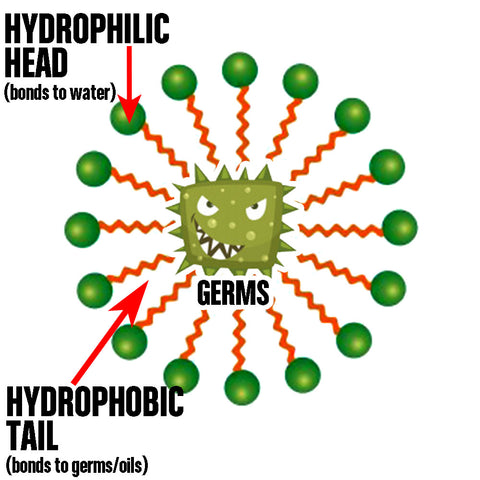How Soap Kills Coronavirus (COVID-19) and other Bacteria
March 18, 2020 4 min read
Properly washing your hands and maintaining “social distance” is all the talk these days. And while the world has seemed to come to a near halt with this Coronavirus outbreak, it’s hard to believe that plain old soap and water is still the best way to clean your hands and prevent the spread of COVID-19 and other diseases.
Studies have shown that washing your hands with soap and water for 20 seconds reduces bacterial counts by up to 90%. And washing even further past 30 seconds - this percentage jumps even high to 99.9%.
With all this said, we want to educate you on proper handwashing techniques to help you avoid catching and spreading bacteria, as well as showing you how and why soap works so well at killing bacteria and viruses.
_______________________________________________________________
Most of the flu viruses are transmitted through the air in virus-laden droplets, which get there through coughing, sneezing, or in some cases, from simply breathing. Our hands then pick up these droplets from many surfaces, and then they are easily transmitted into your body after touching your body/face.
While soap and water do permanently kill most germs, it doesn’t kill every strain of bacteria out there. However, if the soap doesn’t kill the bacteria, it still works effectively by physically removing the bacteria from your hands. Let us explain:
_______________________________________________________________
What is Soap:
Soaps are made of pin-shaped molecules that contain two “heads.” One end is a hydrophilic head (bonds with water), and the other is a hydrophobic tail (bonds with oils and fatty acids). These soap molecules are suspended in water and float around like an army of individual cleaning molecules. When combined, they then form bubbles, also called micelles, with their hydrophilic (water-loving head) pointing outwards, and their longer hydrophobic tails remain pointing inwards.
How Does Soap Work against Bacteria:

Most bacteria and viruses have lipid (fatty acid) membranes surrounding the outside of them. These membranes are also surrounded with essential proteins that allow certain viruses to infect cells, as well as performing vital tasks that help to keep said bacteria alive. Well known pathogens that are wrapped in lipid membranes include the Coronavirus, Ebola, H.I.V., and numerous other bacteria that attack the intestines and respiratory tract.
Soaps, when appropriately used, are very effective at rupturing and killing many types of bacteria and viruses, including the new Coronavirus that is currently a global issue. People usually think of soap as something mild and gentle. But from the perspective of many bacteria and microorganisms, it is very destructive. The reason for this is soaps hydrophilic ends, which essentially bond to and dissolve the fat membrane of the virus, causing it to fall apart and become useless. Furthermore, soap molecules then work to disrupt the chemical bonds that allow bacteria, viruses, grease, and grime to stick to surfaces allowing them to be “lifted” off the skin. Micelles (bubbles) form around bacteria particles and dirt, basically trapping them in floating cages (aka bubbles). When you then rinse your hands, the microorganisms that were damaged, trapped, and killed by the soap are then washed away from your skin.
According to the CDC: “soap and friction help lift dirt, grease, and microbes – including disease-causing germs – from the skin so they can be rinsed off of hands.

Soaps Vs. Hand Sanitizers:
In general, hand sanitizers are not as fully reliable as soap can be. Sanitizers that contain at least 60% ethyl alcohol act similarly to soap by wiping out bacteria and viruses, destroying their lipid (fatty acid) membranes. However, they do not easily remove microorganisms from the skin so much as they do kill them. Soap does a much better job of physically removing and washing away the bacteria from your skin. This is one of the main reasons pure soap and water is favored in the food industry. However, hand sanitizers are a great alternative when traveling, or you do not have access to a sink with soap and water.
However, it is to be recognized that the problem of diseases being spread by dirty hands is not just a soap versus sanitizer problem. It is more so that the public is not washing their hands adequately and frequently enough, according to the Center for Disease Control and Prevention (CDC).
How to wash your hands of COVID-19:
Even people who are conscientious about washing their hands sometimes make the mistake of rushing it or not doing it correctly. We wanted to give you a few tips to make sure you get the most out of washing your hands to make sure you don’t get sick.
- Make sure you wash long enough – In short, you can’t OVER WASH your hands, but you can indeed UNDER WASH. Make sure you scrub 30 seconds or more – the longer, the better.
- Work up a good lather – rub your hands quickly together to build a good lather with the soap. Doing this increases the number and strength of the soap micelles, trapping even more bacteria and dirt.
- Scrub all areas – bacteria and dirt don’t end up on just the palms of your hands. Make sure you scrub the back of your hand, knuckles, fingertips, and even the cuffs of your wrist.
- Warm water – soap tends to perform better with warm water and will effectively remove more bacteria and grime with warmer temperatures.
- Dry well – remove any excess water left behind and dry your hands thoroughly. Doing this further removes any soap that may not have been rinsed off.
All of our soaps here at Grip Clean will work to help clean your hands of bacteria and viruses when used properly. View our store to see all our hand care products.
Subscribe
Sign up to get the latest on sales, new releases and more …
